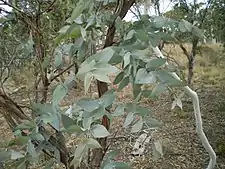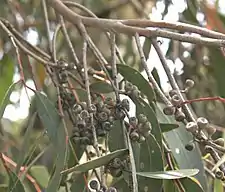Eucalyptus dives
Eucalyptus dives, commonly known as the broad-leaved peppermint or blue peppermint,[2] is a species of tree that is endemic to south-eastern Australia. It has rough, finely fibrous bark on the trunk and larger branches, smooth bark above, lance-shaped or curved adult leaves, flower buds in groups of eleven or more, white flowers and cup-shaped, hemispherical or conical fruit.



| Broad-leaved peppermint | |
|---|---|
 | |
| Eucalyptus dives in the ANBG | |
| Scientific classification | |
| Kingdom: | Plantae |
| Clade: | Tracheophytes |
| Clade: | Angiosperms |
| Clade: | Eudicots |
| Clade: | Rosids |
| Order: | Myrtales |
| Family: | Myrtaceae |
| Genus: | Eucalyptus |
| Species: | E. dives |
| Binomial name | |
| Eucalyptus dives | |
Description
Eucalyptus dives is a tree that grows to a height of 20 m (66 ft) and forms a lignotuber. The bark on the trunk and larger branches is rough, finely fibrous and greyish and smooth grey on the thinner branches. Young plants and coppice regrowth have leaves arranged in opposite pairs, egg-shaped to heart-shaped or curved, 60–140 mm (2.4–5.5 in) long and 20–70 mm (0.79–2.76 in) wide and sessile. Adult leaves are arranged alternately, lance-shaped to curved, the same slightly glossy or dull green on both sides, 70–150 mm (2.8–5.9 in) long and 14–42 mm (0.55–1.65 in) wide on a petiole 5–33 mm (0.2–1 in) long. The flower buds are usually arranged in groups of eleven or more in leaf axils on an unbranched peduncle 3–13 mm (0.1–0.5 in) long, the individual buds on a pedicel 2–7 mm (0.08–0.3 in) long. Mature buds are oval to club-shaped, 3–6 mm (0.12–0.24 in) long and 2–4 mm (0.079–0.157 in) wide with a conical to rounded operculum. Flowering occurs from September to January and the flowers are white. The fruit is a woody, cup-shaped, hemispherical or conical capsule, 3–7 mm (0.12–0.28 in) long and 4–8 mm (0.16–0.31 in) wide and sessile or on a pedicel up to 5 mm (0.20 in) long with the valves near the level of the rim.[2][3][4][5]
Taxonomy and naming
Eucalyptus dives was first formally described in 1843 by Johannes Conrad Schauer and the description was published in Walpers' book Repertorium Botanices Systematicae (Volume 2).[6][7] The specific epithet (dives) is a Latin word meaning "rich"[8] referring to the rich oil content of the leaves.[2]
Distribution and habitat
Broad-leaved peppermint usually grows in poor, dryish soils in open forest and woodland, usually in poor, shallow, stony soils in higher places. It is found in New South Wales south from Niangala in New South Wales and in south-eastern Victoria.
Uses
Essential oils
This eucalypt is a source of Eucalyptus oil and yields up to 12.75% by weight of partly dried leaves. Some forms of E. dives contain mostly the essential oils phellandrene and piperitone, some also contain eucalyptol and the remainder eucalyptol, terpineol, geraniol and citral.[9]
In the early post-war years there was a shortage of menthol and several manufacturers were able to produce this oil from piperitone but gradually this method was displaced by production of the oil from Mentha arvensis. The form rich in cineole is still harvested in New South Wales while the seeds imported into Africa are mostly from the piperitone/phellandrene form.[10]
References
- "Eucalyptus dives". Australian Plant Census. Retrieved 23 June 2019.
- "Eucalyptus dives". Euclid: Centre for Australian National Biodiversity Researdch. Retrieved 4 June 2020.
- Brooker, M. Ian; Slee, Andrew V. "Eucalyptus dives". Royal Botanic Gardens Victoria. Retrieved 23 June 2019.
- Hill, Ken D. "Eucalyptus dives". Royal Botanic Garden Sydney. Retrieved 23 June 2019.
- Chippendale, George M. "Eucalyptus dives". Australian Biological Resources Study, Department of the Environment and Energy, Canberra. Retrieved 23 June 2019.
- "Eucalyptus dives". APNI. Retrieved 23 June 2019.
- Schauer, Johannes; Walpers, Wilhelm (ed.) (1843). Repertorium Botanices Systematicae. New York: Sumtibus Frederici Hofmeister. p. 926. Retrieved 23 June 2019.CS1 maint: extra text: authors list (link)
- Brown, Roland Wilbur (1956). The Composition of Scientific Words. Washington, D.C.: Smithsonian Institution Press. p. 274.
- Southwell, Ian (June 1992). "Eucalyptus leaf oils: Use, chemistry, distillation and marketing". Phytochemistry. 31 (6): 2193. doi:10.1016/0031-9422(92)80403-2.
- Coppen, John J.W. (25 April 2002). Eucalyptus : The Genus Eucalyptus. London; New York: Taylor & Francis. pp. 186–221. ISBN 9780415278799.
- Boland, et al., Eucalyptus Leaf Oils - Use, Chemistry, Distillation and Marketing, ISBN 0-909605-69-6.